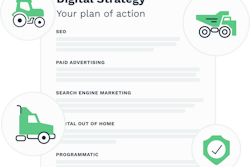
As the new year dawned, so did aftermarket and dealer operation hopes for a better year. Or at least better than 2024.
“In the first part of the year and the change in administration, if the administration did nothing, we’d continue along a healthy path,” Eric Starks said in a December webinar.
The new administration, led by President Donald J. Trump, shook things up. As he had promised on the campaign trail, Trump kicked off a on-again, off-again tariff program that threw markets and supply chains into turmoil, and may just prolong the industry’s freight recession.
“Freight is very much in the crosshairs of the trade war,” Tim Denoyer, vice president and senior analyst with ACT Research, said.
[RELATED: Tariff and trade uncertainty hurting industry optimism for 2025]

Rolling and ever-changing tariffs don’t just have manufacturers and retailers holding their breath. The heavy-duty aftermarket is too. Trucks, Parts, Service recently asked its readers to weigh in on how their business investment plans have changed since the disruption took hold. The majority of TPS’ respondents (60%) said yes, they did plan to spend on capital expenditures and business investment.
And, unsurprisingly, since Jan. 20, those plans have changed. Nearly half of respondents (45%) said their investment plans changed. Another 35% said they hadn’t changed, and 20% didn’t know.
In a March webinar, FTR analysts said the uncertainty is curbing businesses’ willingness to let go of any ready cash or take on any new obligations.

“We’re not in an environment where we’re following normal practice. It adds a whole lot more uncertainty into the market for the next year or so,” FTR Vice President of Trucking Avery Vise said.
The uncertainty is showing up in economic data from the first half of the year, too. ACT lowered its forecasts for the year in March, and as earnings reports rolled in, more and more companies cut out their long-range forecasts.
Jonathan Starks, CEO at FTR, likened it to the fog of war.
“There’s a lot of fear out there,” he said in a May webinar. “Everyone’s making short-term decisions right now,” saving long-term decisions for when there’s more clarity. Also awaiting clarity are analysts’ expectations for the rest of the year.
Bill Witte, FTR economist, says the first quarter of 2025 didn’t look too bad, “but it was not really very well balanced” as businesses pulled forward inventories ahead of tariffs taking effect. With a pull forward, however, always comes a payback.
“As is always the case with pulling forward activity, there are paybacks,” ACT’s President Kenny Vieth says.
A little more than half (53%) of survey respondents said they’re monitoring market conditions closely. Around a third (30%) are on pins and needles. Just 17% say it’s business as usual.
Aaron Huber is the business development products at Orscheln Products. His company, headquartered in Missouri, makes control solutions for commercial vehicles and has been in business for more than 70 years. It has operations in England and India.
“We’re fairly global, but not too big,” Huber says. “This whole thing … has kind of smacked us upside the head.”
The fact trucks need their products to run has protected Orscheln to some extent, but Huber says the family-owned company cannot absorb the costs of tariffs and must pass it along to its customers. Orscheln is being transparent, Huber says, but they’ve still had customers reject shipments and pull back on orders.
To cope, Orscheln is pulling back on projects and manage expenses, cutting travel and capital expenditures and reprioritizing projects. It’s also cut hours in the shop, sliced into shift work and instituted a hiring freeze.
[RELATED: Volvo Group reducing plant workforces]
Huber says 10-20% of the company’s total product spend comes from China and is subject to the 145% tariff on the country’s goods. Some of the components Orscheln sources have doubled in price.
“We’re in the process of negotiating with customers,” Huber says. “We can’t absorb any of that. We wouldn’t be able to survive.”
He says his procurement team is doing a good job of moving around and is looking for domestic sources when it can, but not everything is available domestically. A particular problem is with magnets the company uses in its control solutions. It gets them from China, which as restricted exportation as part of retaliation for the tariffs.
“At some point later this year, we’re going to run out of magnets,” Huber says.
The worry about costs and sourcing is time consuming and stress inducing.
“I’ve been spending probably 25% of my week working on this lately,” he says. “It’s taking a lot of time from trying to sell stuff.”
Customers have been telling Huber’s team to hold shipments while they work out their own difficulties, even though OEM orders are still moving through because Orscheln’s systems are necessary components.
While some TPS readers say they’re on pins and needles waiting for the outcome of these policy decisions, even more are monitoring it closely but not ringing alarms quite yet.
“Obviously, the uncertainty is the issue,” one respondent says. “We have put a hold on most of [our] plans because you can’t make effective plans with uncertain information.”
Some other respondents say they’re not being affected at all.
“Typical of trucking,” another respondent wrote. “Up and down! But more up than down!”










